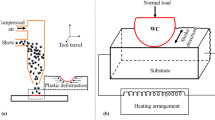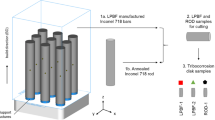Abstract
In this work, the analysis of failure mechanism in the heat affected zone is described in dissimilar weld joints between advanced martensitic steel T92 and Ni-base weld metal. The joints were treated with two different post-weld heat treatments and tested. For the creep, tensile, and Charpy impact tests, the samples with interfacially located notch were used. Moreover long term aging at 625 °C was applied before the tensile and notch toughness tests. Decohesion fractures ran along carbides at the T92 BM/WM interfaces in case of the modified PWHT, whereas type IV cracking was the prevailing failure mechanism after the classical PWHT in the creep test. In the notch tensile and Charpy impact tests, with the notch at T92 base metal/weld metal interface, fractures ran along the interface with a hard phase on the fracture surface along with the ductile dimple and brittle quasi-cleavage fracture. The phase identified as niobium boride (either NbB and/or Nb3B2) was produced during welding at the end of the solidification process. It was found in the welds regardless of the post-weld heat treatment and long-term aging.

















Similar content being viewed by others
References
A.K. Bhaduri, S. Venkadesan, P. Rodriguez, and P.G. Mukuda, Transition Metal Joints for Steam Generators—An Overview, Int. J. Press. Vessel Pip., 1994, 58, p 251–265
J. Hou, W. Peng, Y. Takeda et al., Microstructure And Stress Corrosion Cracking of the Fusion Boundary Region in an Alloy 182-A533B Low Alloy Steel Dissimilar Weld Joint, Corr. Sci., 2010, 52, p 3949–3954
R. Anand, C. Sudha, T. Karthikeyan et al., Effectiveness of Ni-Based Diffusion Barriers in Preventing Hard Zone Formation in Ferritic Steel Joints, Mater. Sci., 2009, 44, p 257–265
Qunjia Peng, He Xue, J. Hou, K. Sakaguchi et al., Role of Water Chemistry and Microstructure In Stress Corrosion Cracking in the Fusion Boundary Region of an Alloy 182-A533B Low Alloy Steel Dissimilar Weld Joint in High Temperature Water, Corr. Sci., 2011, 53, p 4309–4317
J.A. Francis, W. Mazur, and H.K.D.H. Bhadeshia, Type IV Cracking in Ferritic Power Plant Steel, Mater. Sci. Technol., 2006, 22, p 1387–1395
F. Abe, T.U. Kern, and R. Viswanathan, Creep-Resistant Steels, Woodhead Publishing Limited, Cambridge, 2008, p 491–498
F. Abe, M. Tabuchi, M. Kondo, and S. Tsukamoto, Suppression of Type IV Fracture and Improvement of Creep Strength of 9Cr Steel Welded Joints by Boron Addition, Int. J. Press. Vessel Pip., 2007, 84, p 44–52
M. Tabuchi, M. Kondo, K. Kubo, and S.K. Albert, Improvement of Type IV Cracking Resistance of 9Cr Heat Resisting Steels by Boron Addition, OMMI, 2004, 3, p 1–11
J.P. Ennis, The mechanical properties and microstructures of 9% chromium steel P92 weldments, OMMI, 2002, 1, p 1–23
L. Falat, L. Čiripová, J. Kepič, J. Buršík, and I. Podstranská, Correlation between microstructure and creep performance of martensitic/austenitic transition weldment in dependence of its post-weld heat treatment, Eng Fail Anal, 2014, 40, p 141–152
J. Kepič, “Degradation of the Microstructure and Properties of Advanced Creep Resistant Steels Weld Joints,” Ph.D. Thesis, TU, Košice, 2011
F. Abe, T. Horiuchi, M. Taneike, and K. Sawada, Stabilization of Martensitic Microstructure in Advanced 9Cr Steels During Creep at High Temperature, Mater. Sci. Eng. A, 2004, 378, p 299–303
R.D. Nicholson and J.A. Williams, Failure and Deformation Modes in Heavy Section Dissimilar Welds Subjected to Accelerated Thermal Cycle: Creep Loading, Int. J. Press. Vessel. Pip, 1985, 20, p 239–274
A. Výrostková, R. Macko, J. Blach, and L. Čiripová, Comparison of the Heat Affected Zones and Base Metals of 0.5-9% Steels to Hydrogen Embrittlement Sensitivity, 22nd International Conference on Metallurgy and Materials (Brno, Czech Republic) Tanger, 2013
L. Falat, V. Homolová, J. Kepič, M. Svoboda, and A. Výrostková, Microstructure and Properties Degradation of P/T91, 92 Steel Welds in Creep Conditions, J. Min. Metall. Sect. B, 2012, 48B, p 461–469
Yu Nakama, Hiroshi Ohtani, and Mitsuhiro Hasebe, Thermodynamic Analysis of the Nb-Ti-B Ternary Phase Diagram, Mater. Trans., 2009, 50, p 984–993
Lippold JC, Nissley NE. Ductility-Dip Cracking in High Chromium, Ni-Base Filler Metals, the 2nd International Workshop on Hot Cracking Phenomena in Welds Berlin 2007, p. 409–25
A.J. Ramirez and J.C. Lippold, High Temperature Behaviour of Ni-Base Weld Metal, Part I. Ductility and Microstructure Characterization, Mater. Sci. Eng., 2004, A380, p 259–271
A. Ugur Sen, B. Suleyman Serdar Pazarlıoglu, and B. Saduman Sen, Niobium Boride Coating on AISI, M2 Steel by Boro-Niobizing Treatment, Materials Letters, 2008, 62, p 2444–2446
A.M. Shariatpanahi and H. Farhangi, Microstructure and Mechanical Properties of Dissimilar Ferritic and Austenitic Steel Joints with an Intermediate Inconel-182 Buttering Layer, Adv. Mater. Res., 2009, 83–86, p 449–456
S.W. Banovic, J.N. DuPont, and A.R. Marder, Dilution and Microsegregation in Dissimilar Metal Welds Between Super Austenitic Stainless Steel and Nickel Base Alloys, Sci. Technol. Weld. Join., 2002, 7, p 374–383
S.L. Jeng and Y.H. Chang, Influence of Nb and Mo on the Microstructure and Mechanical Properties of Ni-Cr-Fe GTAW Welds, Mater. Sci. Eng., 2012, A555, p 1–12
B.T. Alexandrov, A.T. Hope, J.W. Sowards et al., Weldability Studies of high-Cr, Ni-Base Filler Metals for Power Generation Applications, Weld. World, 2011, 55, p 65–76
ChQ Guo and P.M. Kelly, Boron Solubility in Fe-Cr-B Cast Irons, Mater. Sci. Eng., 2003, A352, p 40–45
J. Hald, Z. Kuboň, A. Strang, and D.I. Gooch, Microstructural Development and Stability in High Chromium Ferritic Power Plant Steels, Institute of Materials, London, 1997, p 159–177
B.S. Srinivas Prasad, V.B. Rajkumar, and K.C. Hari Kumar, Numerical Simulation of Precipitate Evolution in Ferritic–Martensitic Power Plant Steels, CALPHAD, 2012, 36, p 1–7
Acknowledgment
The work was supported by Slovak agency VEGA under the projects No. 2/0116/13 and 2/0153/15. Authors are thankful to Dr. M. Černík from the USS Košice for the XRD analysis.
Author information
Authors and Affiliations
Corresponding author
Rights and permissions
About this article
Cite this article
Výrostková, A., Kepič, J., Homolová, V. et al. Precipitation of Niobium Boride Phases at the Base Metal/Weld Metal Interface in Dissimilar Weld Joints. J. of Materi Eng and Perform 24, 2699–2708 (2015). https://doi.org/10.1007/s11665-015-1560-8
Received:
Revised:
Published:
Issue Date:
DOI: https://doi.org/10.1007/s11665-015-1560-8




